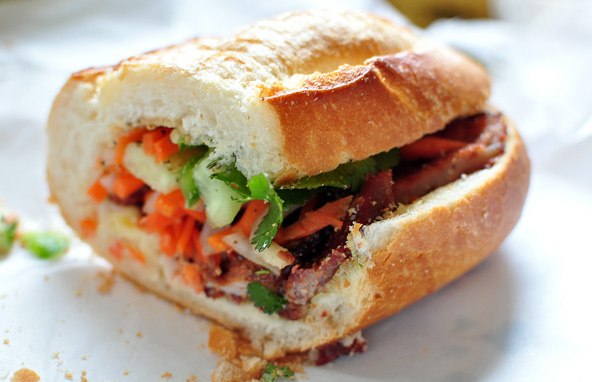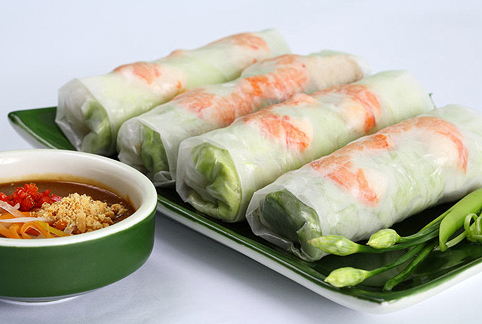1. Bánh mì (banh mi) - number one food to try in Ho Chi Minh city

Banh mi, like Pho, is the most exported Vietnamese specialty. Banh mi means bread but actually it refers to baguette sandwich filled with a variety of different things. Banh mi is easily found on every street on Vietnam, yet banh mi Saigon has unique flavors that allure many food lovers.
There are many different varieties of banh mi but the basic sandwich starts with a crusty baguette that’s sliced in half and stuffed with layers of pork, luncheon meats, shredded cured pork skin, pâté, mayonnaise, radish and carrot pickles, a handful of sliced cucumbers, sprigs of coriander (cilantro), and last but not least, an optional, yet in my opinion necessary, scoop of fresh pounded chilies.
2. Ốp la (op la) - Omelette eggs

A beautiful alternative to the banh mi sandwich is a dish called op la, or eggs cooked in a littler personal pan, often supplemented by slices of meat like ham, onions, and served with those wonderful crusty Vietnamese baguettes.
Banh mi op la makes a favorite breakfast food for many locals in Ho Chi Minh city, and it most definitely hits the spot before a long day exploring the city.
3. Phở (pho) - noodle soup, top food to eat in Ho Chi Minh
Pho, of course, is a must. Pho is the combination of soft rice noodles in a soup broth, normally prepared with either bo (beef) or ga (chicken). However, the flavor of soup broth is different with the soup in the North Vietnam. The soup broth is cooked with more type of herbs and a bit sweet.
Pho in Saigon is also served with a plate of fresh herbs, typically including bean sprout, mint, and coriander.
4. Bun - Rice vermicelli soup

There are many types of bun, bun rieu, bun mam, bun bo Nam Bo... Bun, rice vermicelli, is combined with different things to make different dishes. Bun rieu is a Vietnamese crab based soup noodle dish.
The soup calls for crab paste made from paddy crabs, which give the broth its main flavor, along with stewed tomatoes, that contribute a slightly tart and natural sweetness to the dish.
The complex mixture of ingredients and flavors in the broth, paired with rice vermicelli noodles, pieces of meat and crab paste, a beautiful selection of condiments like shrimp paste, chilies, and limes, and finally a pile of both blanched and raw vegetables, is what makes the dish so delicious.
Bun mam is typically dish in the Southern Vietnam. The base of any bowl of bun mam (bún mắm) is a dark colored broth prepared with fermented fish sauce. The fermented fish sauce gives the soup broth a well rounded, balanced flavor, and it’s honestly not nearly as fishy as it might sound or smell.
- Along with the broth, bun, or rice vermicelli noodles, are loaded into the bottom of the bowl, before the entire assortment of meats like squid, prawns, and pork are all scattered on top of the noodles.
- Finally, a slice or two of eggplant, which soaks up all the broth, is another essential component of a bowl of southern Vietnamese bun mam.
- In addition to the glorious fish flavor, the broth of a bowl of bun mam is usually sweetened with tamarind juice and sugar.
5. Hủ tiếu Nam Vang (Hu tieu Nam Vang)

Hu tieu (pronounced "hoo tee-u") signals a Chinese-Southeast Asian style noodle soup made with a pork bone broth and no fish sauce. But that's where simplicity ends. The noodles in a bowl of hu tieu can be chewy clear tapioca noodles, opaque white rice noodles like you'd use for pho noodle soup, or thin Chinese egg noodles (mi). The toppings cover a wide territory, and may include boneless pork, pork ribs, pork offal, shrimp, squid, wonton dumplings, fried garlic, fried shallot, and/or scallion. As usual, you pick and choose whatever you want.
6. Bún thịt nướng (bun thit nuong) - grilled pork with vermicelli

The dish normally begins with a handful of chopped up herbs and lettuce at the bottom of a bowl, then in goes fresh rice vermicelli noodles then a few skewers of grilled pork are layered on that, and finally a sweet and salty fish sauce, and a scoop of oily chives and green onions, and pickles are all added on top.
If you get the bun thit nuong cha gio, in addition to everything already mentioned, you’ll also get a fried spring or two chopped up on top, which bumps the delicious-meter up another notch.
The noodles are soft and silky, the pork is tender, salty, and sweet, and the egg rolls (cha gio) add a beautiful crunch to everything.
Bun thit nuong is a Ho Chi Minh food you should for sure not miss when you travel in this city.
7. Bánh xèo (banh xeo) - Vietnamese pan cake - must eat food dish in Ho Chi Minh
Sort of like a crepe, a Vietnamese banh xeo is a crispy savory snack that’s a favorite for many.
A thin layer of batter is fried in a lot of oil, then combined with your choice of ingredients, often including slices of pork belly, shrimp, and onions, then folded over with a handful of lightly cooked bean sprouts in the middle.
You can really eat banh xeo however you want, but the common method is to take a few leaves of lettuce or mustard leaves, load in a piece of the golden crispy crepe, top it with some more herbs like sweet basil and perilla leaves, add some chili (or a lot of it), roll it up like a green spring roll, and then dip the entire treat into the sweet Vietnamese fish sauce dressing.
8. Gỏi cuốn & chả giò - Vietnamese spring rolls & summer rolls

Goi cuon, summer rolls, are made with rice paper, known as banh trang, that’s slightly moistened, then filled with, typically a mixture of rice vermicelli noodles, pieces of pork, shrimp, and then stuffed with leaves and herbs like basil and lettuce before being wrapped.
Finally, Vietnamese summer rolls are often served with a nutty hoisin dipping sauce and accompanied by freshly ground chili.
Cha gio, are completely different taste-wise than their goi cuon counterparts, and they share few characteristics other than their egg roll shape and the fact that they’re often sold side by side at many restaurants and street food stalls.
Cha gio are Vietnamese deep fried spring rolls, a combination of mung bean noodles, minced pork, and sometimes crab if you can find them, mixed with a subtle blend of salty spices, wrapped in rice paper, and then deep fried to a crisp.
9. Cơm tấm sườn nướng (com tam suon) - Grilled porl chop with broken rice
Cơm tấm sườn nướng is the broken rice and a thin grilled pork chop, served on a plate and accompanied by fish sauce dressing, cucumber pickles, green onion oil, and chilies to garnish.
Com tam suon nuong is available all over in Saigon, especially at small street food stalls and markets throughout the city.
10. Ốc (snail)
Ốc (oc), as they are known in Vietnamese, can basically refer to any type of snails, usually saltwater, and they are so popular, they could be considered a major part of the Vietnamese culture of Saigon.
When you go to a quan oc, or a snail restaurant, there are typically dozens of different snails to choose from, as well as other shells like blood cockles, clams, and often shrimp and crab as well.
The seafood selection of the day is normally proudly displayed at the front of the food stall or restaurant, and you proceed to choose whatever looks good to you.
After you choose the type of raw snails you’d like to eat, then choose a method for it to be cooked – like grilled, sautéed, coated in salt and chili, steamed, curried, and so on – I think there are often about 5 – 6 different cooking methods.
Ordering can get a little confusing, but just keep in mind that even though you might not have a clue what you’re about to get on your dinner table, that’s part of the fun.
Shells are usually prepared on small plates, a bunch of different types of snail are all ordered, each cooked in a different method. Eating oc with family, friends, or co-workers, and enjoying a couple beers, is a favorite Saigon way to socialize.